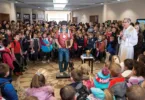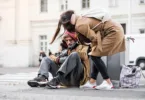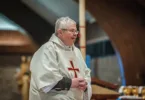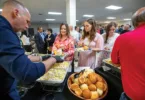
A Salvadoran immigrant carries her son in a field in Huehuetoca, Mexico, while trying to reach the U.S.-Mexico border in 2015. (CNS photo/Edgard Garrido, Reuters)
by Katie Hyde
Special to The Leaven
DILLEY, Tex. — The women and children sitting in the waiting room are dressed in such bright coats — vibrant pops of yellow, red, blue and green —I momentarily forget that we are in jail.
But the reality of where we are sinks in as my first client of the day, Kerlyn, dressed in her government- issued bright blue coat and sweater, starts to cry as soon as she sits down to speak with me.
She had arrived here in Texas days ago after fleeing Honduras with little more than her 4-year-old daughter in her arms.
Kerlyn begins telling her story of the day her 15-year-old daughter Bessy was kidnapped in broad daylight by a drug lord. The day of her kidnapping, Bessy left her home in a small coastal town in Honduras to run some errands.
She never returned home.
After speaking with witnesses, Kerlyn learned the horrifying truth: Her daughter had been kidnapped by the son of a narcotrafficking family known internationally for its ruthless violence.
As she continues her story, Kerlyn’s hands are shaking. She is so afraid of the narcotraffickers, she can barely whisper their name to me.
She’s afraid telling me will put me at risk.
Days after the kidnapping, the death threats started.
One day in early October as she sat alone in her home, Kerlyn looked up to see a masked man standing in her living room. He had a gun. He put a finger to his lips. He told Kerlyn to be silent.
Then he said that if she talked to the police, they would kill her and her family.
A different man came to her home four days later and made a similar threat.
Terrified for her life and that of her family, Kerlyn made an unthinkable decision: She would flee north with her family in search of refuge.
She could hardly bear the thought of leaving without knowing if Bessy was safe — or even alive.
But staying would have meant a death sentence for her entire family.
She has not heard any news of Bessy since.
At the end of our conversation, Kerlyn broke down. She grieved for her lost daughter, for her broken family, for the life she left in Honduras.
And I grieved, too.
Welcome to the ‘Residential Center’
Kerlyn is one of thousands of women who has been detained behind the secured fences of the South Texas Family Residential Center (STFRC), the largest immigration detention facility in the United States.
Located in the small town of Dilley, Texas, this “residential center” houses up to 2,400 women and children, mostly Central Americans, who have been detained by U.S. Immigration and Customs Enforcement.
Here, they await an interview with a Homeland Security officer and a decision. Will they be allowed into the country to apply for asylum?
Or will they be deported?
Having worked with immigrants for several years, I was invited to join a team of volunteers for a week at STFRC to help prepare the detained women for their interviews.
But for all my experience, nothing could have prepared me for Kerlyn — and the dozens of other women like her — who shared their stories with me.
Like Ana, a Cuban whose husband was repeatedly threatened with imprisonment and torture by the Castro regime for his work at a Catholic human rights magazine.
Or Kimberley, who was regularly raped, horrifically beaten and stabbed in the stomach by her husband.
Or Juana, who was kidnapped and beaten by a gang, locked into a coffin with her 2-year-old daughter, and left to die on a Guatemalan mountainside.
Nothing could have prepared me to watch a 3-year-old child wipe tears from her mother’s face.
Nothing could have prepared me for the raw grief, trauma and despair I witnessed each day in the women and children, detained like criminals, sitting in that visitation trailer in their distinctive yellow, red, blue and green coats.
Holy families
As the U.S. Catholic Church celebrates National Migration Week from Jan. 7-13, we are called to truly listen to the stories of refugees, and to remember our own immigrant backgrounds as Americans.
Pope Francis explains that “the duty of solidarity is to counter the throwaway culture and give greater attention to those who are weakest, poorest and most vulnerable.”
The detained women and children at STFRC — many of whom have experienced unimaginable suffering — are some of the weakest and most vulnerable among us.
They are not seeking a better life. They did not come here for better jobs or better educations.
Many do not have any close family or friends in the United States. Most do not understand the concept of being “undocumented.” If they had a choice, many would not be here.
They are here because they have fled for their lives.
Despite their tremendous suffering, however, they took time to give thanks.
Many women wept with joy as they told me how grateful they are to be safe in the United States, even though they are in jail.
Nearly every woman I spoke with thanked God for saving her and her family.
And in witnessing their incredible faith, despite the horrors they had endured, it struck me that I was hearing a story I had heard a hundred times. The story of a family who fled persecution, who sought safety in a foreign land and who struggled to find it.
The story of a man who told us that whenever we welcome the stranger, we are welcoming God.
I was hearing the story of the Holy Family.
The colors of hope
As I walked through the San Antonio International Airport, headed back to Kansas City after an exhausting week, I saw them.
Two women and one child, dressed in vibrant coats.
They had just been released from the South Texas Family Residential Center into the United States to continue their fight for asylum in immigration court.
And knowing everything that stood between them and the freedom and safety they so desperately sought — starting a new life in a new country, battling a Kafkaesque immigration system, and overcoming horrific trauma — I nevertheless couldn’t help the feeling of hope welling in me as I saw them at the airport.
When I saw them walking away from me — carrying airport pizzas and sodas in hand — I knew I had seen a holy family in the airport.
Three small, magnificent beacons walked through that airport that day, clothed in bright colors — colors of hope.
Katie Hyde is a former intern of The Leaven and a member of Good Shepherd Parish in Shawnee.







An amazing article!
How many Holy Families are out there, not for seeking better jobs , but to find
Peace for their loved ones, and join us in solidarity as our ancestors did hundreds of years ago.
Wow! Thanks for sharing this story and for telling it in such beautiful terms.